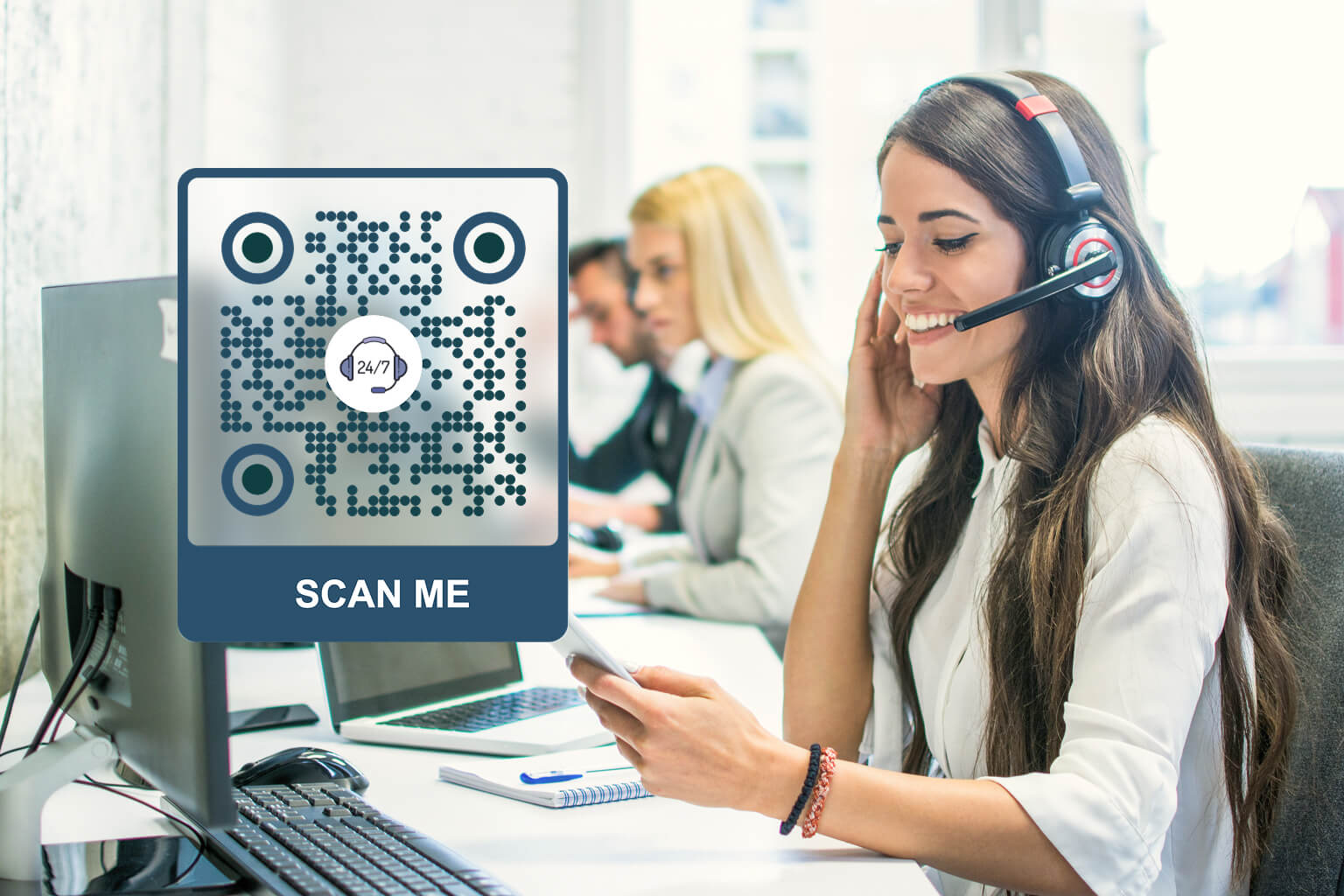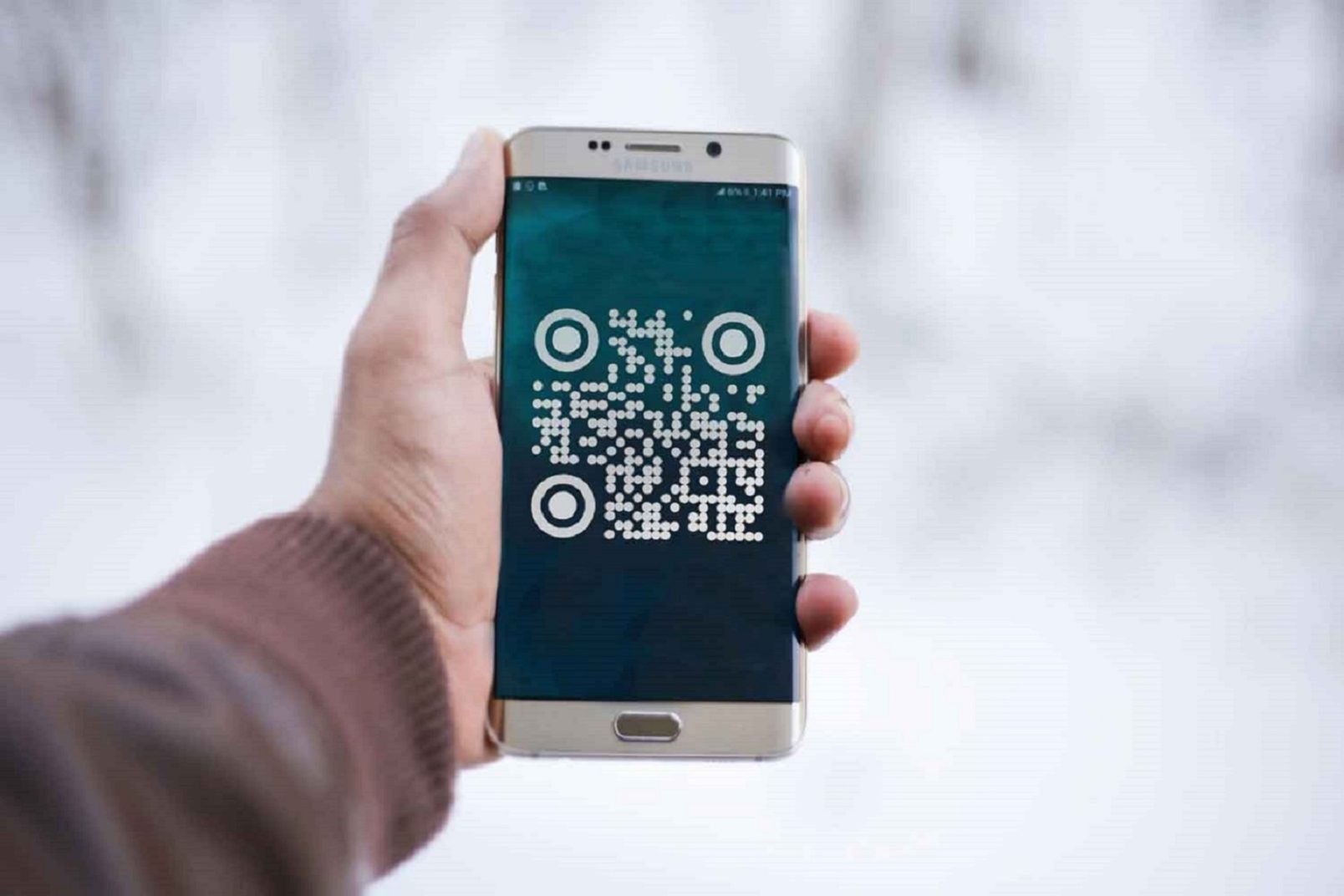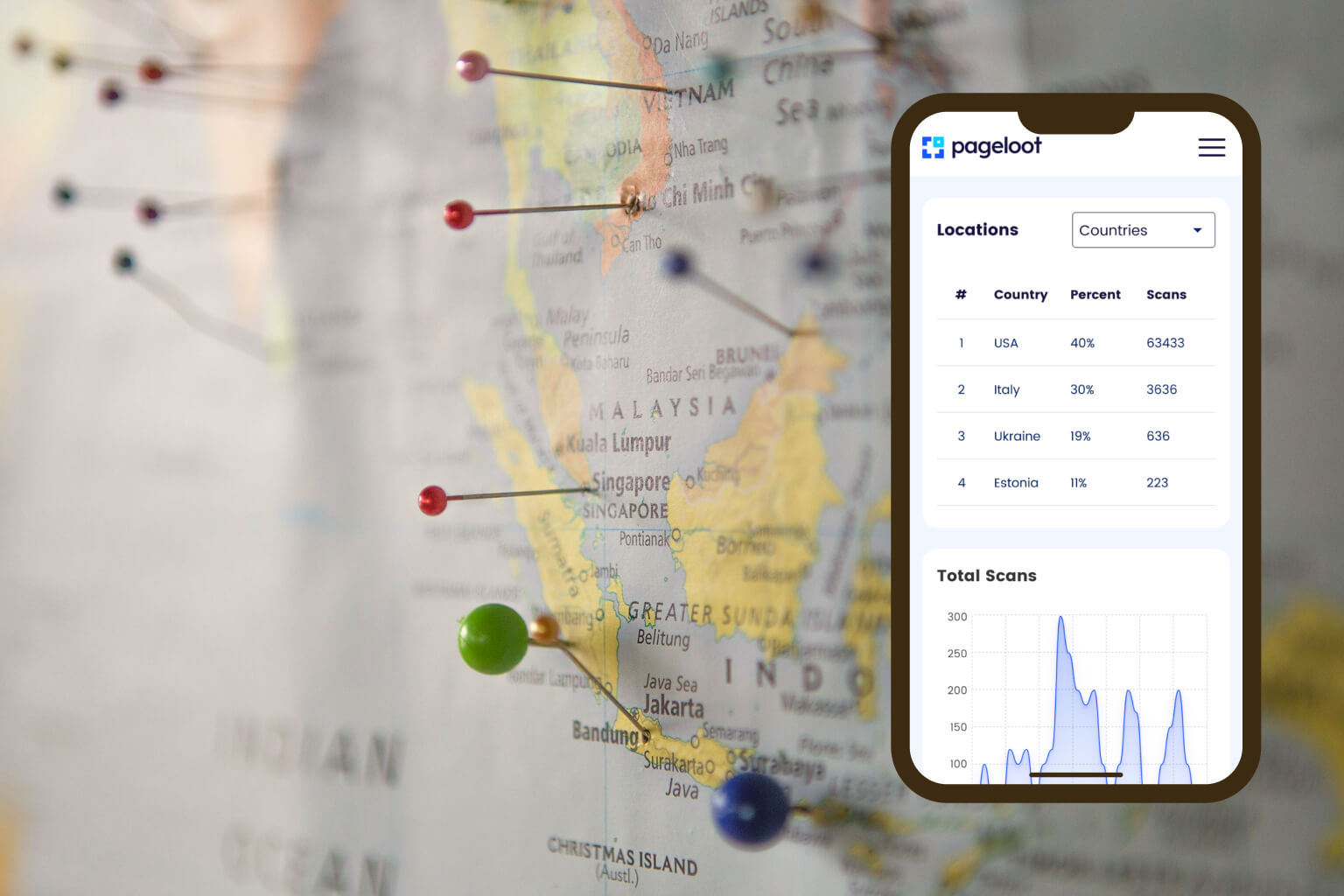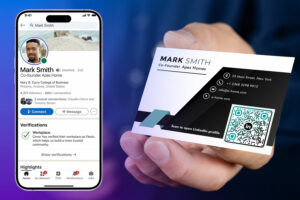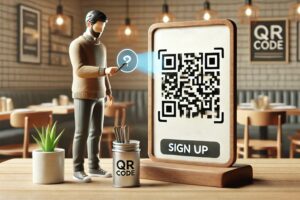QR codes are transforming telecom customer support by making it faster, easier, and more efficient for users to access help. Here’s how:
- Instant Access: Scan QR codes to quickly reach FAQs, troubleshooting guides, or live chat without navigating complex menus.
- Personalized Support: Dynamic QR codes provide device-specific help or account-related solutions.
- Simplified Feedback: QR codes link directly to surveys, improving response rates and gathering real-time insights.
- Cost Savings: Automate tasks like password resets and troubleshooting, reducing the workload on support teams.
- Advanced Analytics: Track scans to understand customer needs and improve service.
How to Generate QR Codes for Calls, SMS, and Emails
Key benefits of QR codes in telecom customer support
QR codes are reshaping telecom customer support by streamlining processes and improving customer satisfaction. In an industry where speed is critical, these digital tools offer practical solutions for common challenges. With 87% of global users finding QR codes easy to use, their potential to enhance telecom support is undeniable.
Faster access to support resources
One of the standout advantages of QR codes is their ability to save customers time. Instead of navigating confusing phone menus or scrolling through lengthy FAQ pages, a quick scan takes users directly to the support resource they need. This not only simplifies the process for customers but also reduces repetitive tasks for support teams, leading to quicker issue resolution.
Telecom companies can make strategic use of QR codes by placing them on product packaging, allowing customers to instantly connect to tech support via phone or SMS. Similarly, email QR codes can be designed with pre-filled subject lines to address common technical problems. This straightforward access paves the way for more efficient and personalized interactions.
Personalized support experiences
Customers increasingly expect support tailored to their specific devices and plans. Dynamic QR codes make this possible by offering updated content based on factors like location, time, or user history.
For example, telecom providers can create device-specific QR codes that link to setup guides, troubleshooting instructions, or account-specific support pages. With 90% of consumers scanning QR codes weekly and 59% engaging daily, these personalized touchpoints have a high potential for boosting engagement. In fact, QR-linked content often achieves 3–4 times higher interaction rates compared to traditional methods.
Simplified feedback collection
Collecting customer feedback has long been a challenge, with traditional methods often yielding low response rates. QR codes simplify this process by connecting users directly to feedback forms or surveys. Whether included on bills, service notifications, or equipment packaging, these codes make it easy for customers to share their thoughts while their experience is still fresh.
For instance, linking to a Google Forms survey can help capture feedback on technical issues or service quality. This real-time input provides actionable insights that companies can use to improve their operations.
Cost savings and improved efficiency
By automating routine tasks, QR codes help telecom companies cut costs and streamline operations. Tasks like password resets, account updates, and basic troubleshooting can be handled without human intervention, allowing support staff to focus on more complex issues. Additionally, QR codes reduce the need for manual data entry, speeding up service delivery and improving overall efficiency.
A great real-world example comes from Bharat Sanchar Nigam Limited (BSNL), which in 2015 added QR codes to landline bills in Kerala. Customers could scan the code to access the payment gateway directly, simplifying the billing process.
As more customers embrace QR code–based self-service options, telecom providers see fewer support tickets and quicker resolutions for remaining issues. For companies looking to maximize these benefits, using a reliable QR code generator ensures consistent branding and dependable performance across all customer touchpoints.
How to implement QR codes for telecom customer support
 To make the most of QR codes in telecom customer support, companies need a clear plan. This means understanding where QR codes can deliver the most value and ensuring their rollout is seamless and effective.
To make the most of QR codes in telecom customer support, companies need a clear plan. This means understanding where QR codes can deliver the most value and ensuring their rollout is seamless and effective.
Identifying use cases for QR codes
Start by linking common customer needs to QR code solutions. Tasks like bill payments, account management, and activating new services are prime opportunities. These are areas where customers often want quick and easy access. In fact, with global QR code payment spending expected to top $3 trillion by 2025, this is a trend worth tapping into.
QR codes can also simplify technical troubleshooting. Instead of customers waiting on hold or navigating complicated phone menus, a quick scan can direct them to device-specific setup guides, network troubleshooting steps, or even helpful video tutorials. Dynamic QR codes on packaging can provide instant access to updated user manuals, warranty information, or support contacts.
Another emerging use case is customer verification, which tackles security concerns. As Ranjan Mathew, Director General of the Cellular Operators Association of India, explains:
"Telecom companies are trying to use the method of electronic verification. It may include using the form generated as one of the documents created from the customer’s base, QR Code".
Creating and customizing QR codes
When it comes to creating QR codes, static codes are great for unchanging information like contact details or FAQ pages. But for telecom needs, dynamic QR codes are often the better choice. They allow updates without needing to reprint materials and provide useful scan analytics.
Customization is key to building trust and reinforcing brand identity. Add your company logo, use brand colors, and maintain consistent design elements. This helps customers quickly recognize legitimate support resources – crucial in an industry where security matters. Make sure every QR code leads to a mobile-friendly page that loads quickly and offers clear next steps.
The wording of your call-to-action can also make a big difference in scan rates. Instead of generic phrases like "Scan here", use targeted messages like "Scan to pay your bill instantly" or "Get setup help in 30 seconds." Test these codes on various devices to ensure compatibility – 89 million US smartphone users scanned QR codes in 2022 alone.
Effective QR code placement
Once you’ve created your QR codes, placing them strategically is essential. Visibility is key, so high-traffic areas like customer service desks or product displays are ideal. Make sure the codes are at a comfortable height for scanning (around 3-4 feet off the ground).
The size of the code matters, too. For close-range scanning, a minimum size of 0.8 x 0.8 inches is recommended. Also, consider the surface and lighting – matte finishes reduce glare, and well-lit areas make scanning easier.
To reach more customers, extend QR code placement beyond physical spaces. Add them to monthly bills, service notifications, email signatures, and even business cards carried by field technicians. Digital platforms like websites and mobile apps are another great way to make QR codes accessible for saving or sharing.
Think about context when deciding where to place codes. For example, troubleshooting codes can go directly on equipment, while setup codes included in product packaging provide instant help when it’s needed most.
Tracking performance with analytics
After deployment, tracking how QR codes perform is crucial. Analyzing scan data offers insights into customer behavior and the effectiveness of your support resources. Metrics like scan frequency, time of day, geographic location, and device type can highlight which resources are being used the most.
Conversion tracking is another valuable tool. It helps measure how many scans lead to successful outcomes, like completed payments or resolved issues. For instance, tracking the percentage of scans that result in a payment can reveal whether adjustments are needed.
If certain codes aren’t performing well, consider tweaking their placement, updating the call-to-action, or improving the destination content. By mapping the customer journey through QR code analytics, you can identify problem areas and make the support process smoother.
Regularly reviewing this data lets you refine your QR code strategy, cut support costs, and improve customer satisfaction.
sbb-itb-74874c9
Advanced QR Code Features and Applications
Telecom companies can take QR codes to the next level, using advanced features to create secure and tailored customer support experiences. These enhanced capabilities turn basic QR codes into powerful tools that adapt to evolving needs and provide actionable insights for businesses.
Dynamic QR Codes: A Smarter Solution
Dynamic QR codes offer the ability to update linked content without the need to reprint materials. This is a game-changer when support resources change, contact details are updated, or new troubleshooting guides are introduced.
For instance, dynamic QR codes can direct customers to live chat systems that automatically connect them to available agents or display real-time technician availability through scheduling tools. If service hours change or emergency protocols are activated, companies can instantly update the QR code’s destination without replacing physical codes on equipment, invoices, or promotional materials.
These codes also come with features like scan tracking, password protection, expiration dates, and custom branding. A dynamic QR code generator allows businesses to create professional, branded codes that build trust while offering the flexibility needed for modern support systems. Over time, the savings are significant – no need to reprint thousands of materials when updates are required, which is especially helpful for field operations where codes appear on equipment labels or even vehicles. Beyond cost efficiency, dynamic QR codes pave the way for deeper customer insights.
Analytics: Unlocking Customer Behavior
QR code analytics provide telecom companies with a clearer picture of customer behavior and support needs. These codes generate valuable data, such as when and where customers most frequently seek help. This information allows businesses to shift from reactive support to proactive service improvements.
With 59% of consumers scanning QR codes daily and QR-initiated interactions achieving a 37% average click-through rate, the engagement potential is enormous. Even more compelling, 95% of businesses report that QR codes help them gather first-party data that traditional support channels miss. Analytics dashboards can identify trends – like peak support hours or regions experiencing specific issues – helping companies make smarter decisions and refine their support processes. When combined with automation, these insights further enhance the customer experience.
Seamless Integration with Marketing Tools
QR codes don’t just stop at support – they can also integrate with marketing automation platforms to deliver personalized experiences. For example, when a customer scans a QR code for assistance, automated systems can send follow-up messages with tailored offers, service upgrades, or educational resources based on their interaction history.
Of course, security is critical when combining QR codes with marketing systems. Features like Single Sign-On (SSO), GDPR compliance, and access controls ensure customer data stays protected while enabling personalized interactions.
"Today’s marketers and enterprise brands demand more than basic QR functionality. They need a solution that drives engagement, protects customer data, captures first-party insights, and integrates seamlessly into their broader marketing ecosystem."
– Sophia Artzi, Performance Marketing Associate
This integration allows for advanced targeting based on customer segments, service tiers, or past interactions. For instance, premium customers could receive faster support options, while new users might be guided through additional onboarding steps.
Prioritizing Security and Data Protection
Advanced QR code systems require strong security measures. With 59% of users reusing passwords across multiple accounts, companies must take precautions to safeguard sensitive data. Password-protected QR codes offer an added layer of security for accessing account management portals or billing systems.
Enterprise-grade certifications, like SOC 2 Type 1, ensure that platforms meet rigorous security standards through regular audits. For telecom companies managing sensitive customer data, these certifications are essential for maintaining trust and meeting compliance requirements.
Additional security features, like age verification tools, prevent minors from accessing inappropriate content, while access controls ensure only authorized personnel can modify QR-linked resources. Using secure domains and branded URLs also boosts customer confidence – branded URLs, for example, can increase click-through rates by 34% compared to generic ones.
Physical security is another consideration. QR codes placed in public spaces should link to general support resources, while those on private documents like bills can safely connect to account-specific tools. This layered approach ensures that security measures match the level of risk associated with each QR code’s use.
Measuring the Impact of QR Codes in Telecom Support
Telecom companies rely on hard data to justify their investment in QR codes and to fine-tune their customer support strategies. But measuring the success of QR codes involves more than just counting scans. It’s about understanding customer behavior, comparing performance metrics before and after implementation, and regularly improving strategies based on actual results. Detailed scan data plays a key role in uncovering customer behaviors and validating these enhancements.
Analyzing QR Code Scan Data
QR code analytics offer telecom companies a closer look at how customers interact with their support systems. These analytics track scans, locations, times, and device types, revealing useful patterns like peak usage times and regional support demands. For example, peak scanning periods might highlight when customers are most likely to face service issues, while location data can pinpoint areas needing additional technical support.
Consider this: 95% of businesses report that QR codes help them gather valuable first-party data that traditional support channels often miss. This real-time data collection provides more accurate insights compared to feedback gathered days later. Using a QR code generator equipped with advanced analytics, telecom companies can monitor these trends and adapt their strategies accordingly. These insights are essential for evaluating the effectiveness of QR codes by comparing performance before and after implementation.
Comparing Before and After Metrics
The real test of QR code success lies in tracking key performance indicators (KPIs) over time. Metrics like resolution times, customer satisfaction scores, and support request volumes can reveal the impact of QR code integration. For instance, QR codes that direct users to troubleshooting guides can dramatically reduce resolution times and lower the number of support calls. When QR codes successfully guide customers to helpful resources, it frees up customer service agents to focus on more complex issues.
The results can be striking: QR-linked content sees 3-4x higher engagement rates compared to traditional outreach methods. By tying these metrics to improvements in customer support, telecom companies can clearly see the value of their QR code initiatives. Establishing baseline metrics before launching QR codes and tracking changes monthly – using both data and customer feedback – provides a clear picture of their effectiveness.
Improving QR Code Strategies
Once the initial results are in, the next step is refining QR code strategies. Telecom companies must continuously adapt based on customer behavior and performance data.
For example, scan data can reveal the best placement for QR codes. If codes on monthly bills generate more scans than those on equipment labels, companies might focus their efforts on bill-based resources. Similarly, content optimization is key – if analytics show that users quickly leave a linked support page, updating that page with better FAQs, improved contact options, or smarter chatbot features can make a big difference.
"QR Code analytics empower marketers to make informed, data-driven decisions that can transform campaign outcomes." – Patrick Augstein, Customer Support Team Manager, Bitly
Companies can also align their staffing with peak scan periods to ensure timely support. Additionally, location-based data can drive regional customization, allowing companies to allocate resources or create content tailored to specific areas.
Ongoing feedback is critical. For instance, 62% of surveyed businesses predict higher sales in 2025 due to QR-focused initiatives. By regularly reviewing analytics and incorporating customer input, telecom companies can identify areas for improvement and adjust their strategies. Keeping QR code content and placement updated based on scan data ensures that customer support remains efficient and responsive to evolving needs.
Conclusion
QR codes have become a game-changer for telecom customer support, offering a fast, self-service option that meets the demands of today’s customers. With 87% of consumers abandoning brands after a single poor support experience, providing accessible and efficient service is no longer optional – it’s essential.
By automating repetitive tasks, QR codes free up support staff to focus on more complex issues. This not only reduces wait times but also helps cut operational costs. When customers can scan a QR code to access troubleshooting guides, initiate live chats, or connect with support instantly, the entire process becomes more streamlined and responsive. To make the most of these benefits, telecom companies need reliable QR code tools.
The impact of great support is clear: 89% of consumers are more likely to make another purchase after a positive service experience. For telecom companies, this means QR codes are a practical way to strengthen customer loyalty and reduce churn.
Tools like Pageloot provide the features telecom companies need to succeed, including dynamic QR codes, real-time analytics, and customization options. These capabilities allow businesses to update content without reprinting codes, track customer interactions, and create visually appealing designs. This ensures QR code solutions stay adaptable, professional, and secure.
The time to act is now. As customer expectations shift toward faster and more convenient support, telecom companies that embrace QR code technology will stand out. Start by identifying key support touchpoints and generate QR codes that provide instant assistance. With the right strategy and ongoing improvements, QR codes can transform your customer support into a key driver of satisfaction and growth.
FAQs
How can QR codes improve customer support in the telecom industry?
QR codes are reshaping customer support in the telecom industry by offering fast and straightforward access to personalized resources. With just a quick scan, customers can instantly connect to troubleshooting guides, live chat support, or account management tools designed to address their specific needs.
Dynamic QR codes take this a step further by allowing telecom companies to update the linked content in real time. This means customers always have access to the most current and relevant information. On top of that, QR codes can be customized with company logos and colors, creating a more professional and branded experience that helps build trust during support interactions. By simplifying access to support and making it more engaging, QR codes not only improve customer satisfaction but also make resolving issues quicker and easier.
How can QR codes help telecom companies save costs in customer support?
QR codes offer telecom companies a smart way to cut costs by making customer support more efficient. Instead of relying heavily on staff, QR codes can direct customers straight to FAQs, troubleshooting guides, or even live chat. This approach not only speeds up issue resolution but also lowers operational expenses by reducing the need for manual assistance.
They also bring savings to billing and payment processes, eliminating costs tied to traditional methods. Plus, because dynamic QR codes can be updated without needing reprints, they remain a budget-friendly option. By integrating QR codes, telecom companies can enhance customer support while keeping expenses in check.
How can telecom companies protect customer data when using QR codes?
To keep customer data safe, telecom companies should rely on secure and compliant QR code solutions equipped with encryption, password protection, and access controls. These features help ensure that sensitive information stays accessible only to authorized individuals.
Using dynamic QR codes further strengthens security. These codes can be updated or even deactivated in real time if any threats emerge. On top of that, educating customers about identifying legitimate QR codes and setting up clear protocols for reporting suspicious activity can reduce the risks of phishing and malware attacks.
By combining reliable QR code technology with proactive safety practices, telecom companies can protect customer data while improving their support services.

